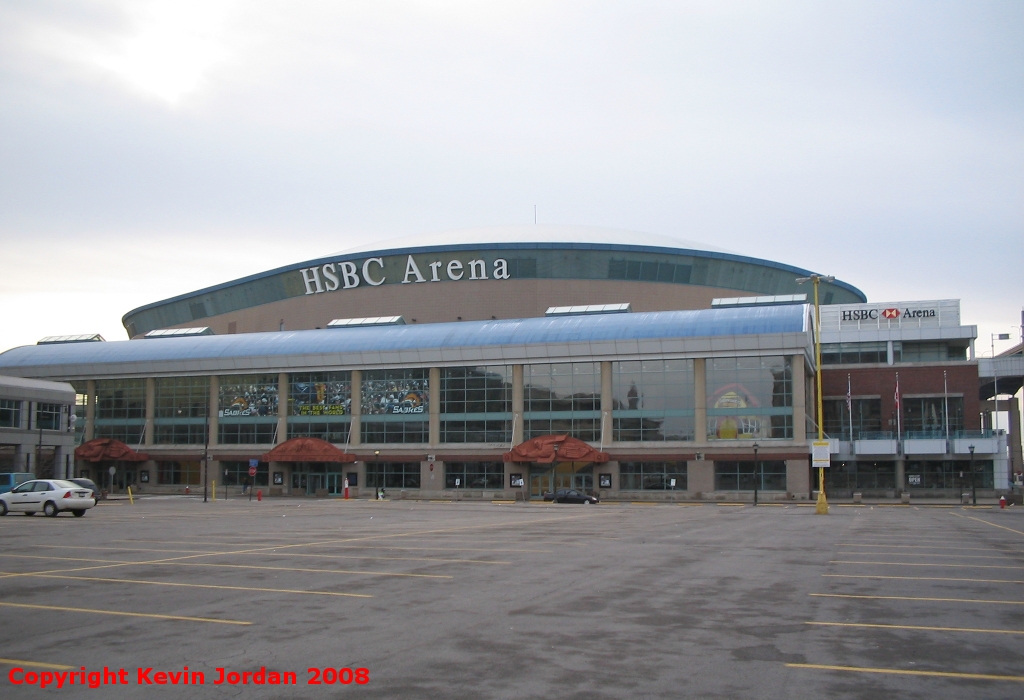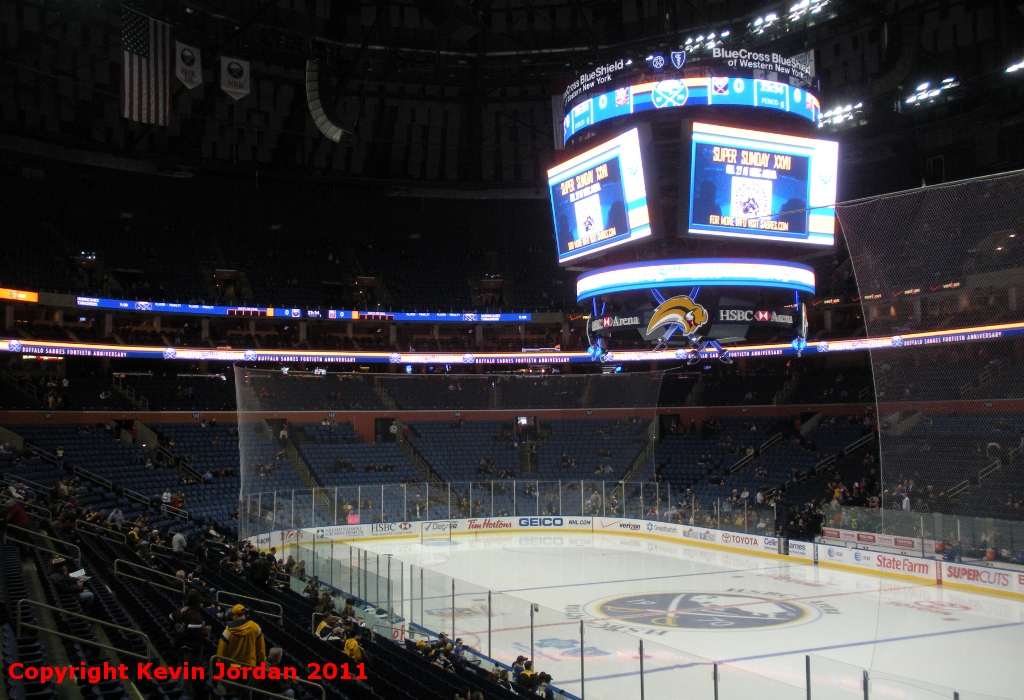
Erie Otters
Arena Name: KeyBank Center
Capacity: 18,690
Built: 1996
Only Game: 2014
Address: One Seymour H. Knox III Plaza, Buffalo, NY, 14203
Ice Surface Size: Regulation
Venue Web Site: KeyBankCenter.com

KeyBank Center

What Was the Arena Like?
First Visit: March 11, 1999 for NHL
In the 2014-15 season, the Buffalo Sabres were tanking their hearts out in an effort at finishing last overall and hopefully drafting Connor McDavid first overall. Meanwhile, a short distance to the west, young McDavid was plying his trade as an Erie Otter. And before you could say "corporate synergy", the Sabres and Otters decided to host an regular season game in October 2014 at their arena in Buffalo, featuring McDavid's Otters playing against the other closest team to Buffalo, the Niagara IceDogs.
So obviously the NHL arena in Buffalo was only a one shot deal, but this guide is nothing if not anally complete, and I've been to see the Sabres some six or seven times at the First Niagara Center, so here are some pictures. What follows is the review I wrote once for Stadium Journey, which may be out of date, but may as well be posted somewhere online since SJ overwrites their reviews annually.
The First Niagara Center opened in downtown Buffalo in 1996 following the closure of the beloved old Memorial Auditorium across the street. The arena itself was meant to anchor the redevelopment of Buffalo's windswept Canalside district, but getting shovels in the ground proved harder than expected, and for the first fifteen years of its life, First Niagara Center sat more or less alone among grain elevators and parking lots. All that is finally changing, though, as shovels are in the ground on the $123 million HarborCenter project across the street from the arena that will feature two NHL-sized ice sheets (which will serve as the Sabres' new practice facility), a hotel, parking garage, and entertainment district.
First Niagara Center has always been a good place to watch a hockey game, but the new development should finally give options within walking distance for pre and post-game as well. Seeing the Sabres in 2013-14 means putting up with a bit of construction dust, but the end result will be spectacular when it's finished.
The best thing that can ever be said about any sporting venue's food selection is that it reflects local taste. Buffalo's local cuisine is spectacular, and the First Niagara Center features delicacies like chicken wings, beef on weck (roast beef au jus on a kummelweck roll), Perry's ice cream, and fried bologna sandwiches. The best food option, though, for atmosphere as much as anything else, is the Pour Man's Aud Club behind section 111. When the Aud was demolished, the old anachronistic alpine bar was saved and has been moved lock, stock and barrel to the new arena. Exposed wainscoting and dark wood, seats from the old arena, and a "1995-96 league leaders" info board are well worth checking out.
When the First Niagara Center opened in 1996, it seemed in many ways as though the Sabres were trying to turn their back on their history, with the Aud, the crossed-Sabres logo, and the blue and gold all abandoned. The late-90's Sabres were also one of the league's worst offenders in the scourge of too-loud, interrupting constant promotions that took all the flow and energy out of the crowd. It took well over a decade, but the Sabres have finally embraced their history, and even in comparison to a couple of years ago, the arena is now doused liberally in blue and gold paint and team logos. The Sabres' history is now on display everywhere and the First Niagara Center finally feels like it belongs to Buffalo and to the Sabres. One of the easiest ways to criticize the arena for the first decade of its life was that it felt like it could have belonged to any NHL team in any market, but that is finally now not the case. First Niagara Center is Buffalo and is the Sabres. Having brought the old organ over helps a great deal as well, and the team has learned how to use their TV timeouts properly and to manage the crowd noise while still fitting in the necessary advertising.
Buffalo is one of my favorite American cities, so it is hard for me to criticize, but... well, within walking distance of the arena is an elevated expressway, grain elevators, a massive construction site, and parking lots. There are a few restaurants just to the east in the cobblestone district that always get packed on gamenights, but for the most part, de nada. The real Buffalo,with some of the best pubs and local restaurants anywhere you'll look, is a short (and free) light rail journey away, up to the Fountain Plaza stop and then west into the Delaware-Elmwood Strip. Surrounding the arena, though, is nothing much of note for the visitor. One hopes this grade will go up substantially when HarborCenter opens in the fall of 2014.
Sabres fans have always been among the best in the NHL. The team's border location means that there's often a sizeable component of Canadians in the crowd, and so the atmosphere tends to combine the knowledgability of the average Canadian fan with the raucous passion of the Americans. Sabres games tend to be loud affairs and the locals have always supported the team with high attendance even when times are tougher. During playoff runs, local bars and restaurants tend to be packed with fans and tickets can be hard to get. Sabres-Leafs tickets can be the hardest to get in the regular season, with locals and Torontonians trading barbs and cheers back and forth throughout the game.
I-190 runs right by the arena, and there's a plethora of surface parking and garages in the immediate area. Buffalo's light rail system is free within the downtown core as well, and it is not difficult at all to find a free parking spot within the core (meters are not monitored after 5 PM or on weekends), get on the train, and be delivered to the arena's front door without spending a dime.
With over 15,000 season ticket holders and the Sabres marketing heavily within the Niagara region and Hamilton as well as Rochester to the east, sellouts are common. Games are classified as platinum, gold, silver, bronze or value depending on demand for the opponent, night of week, etc. Toronto games are always platinum, to make the out-of-towners feel at home paying MLSE prices!
If you're used to paying southern US prices, Sabres tickets can be a bit of a shock, but of the three teams equidistant from my home in London, Ontario (Maple Leafs, Red Wings), the Sabres are by far the cheapest. In such a hockey-mad environment, the Sabres offer the best return on investment of any of the nearby teams.
The Sabres have finally re-embraced their history under the leadership of billionaire owner Terry Pegula, and the HarborCenter development should finally make the First Niagara Center into the lynchpin of a revitalized market. Buffalo's reputation isn't exciting or flashy, but as the locals know, the city is full of hidden gems, walkable neighbourhoods, top-notch pubs and restaurants, and a passion for the local sports teams that is virtually unmatched by any other American cities. A Sabres game is what the NHL experience at its best can be - a loud, knowledgeable sellout crowd cheering on the local team in an environment full of colour and history and traditional organ music. For what it's worth, I'd always choose to go see the Sabres over the two better-known teams near me - the arena is nicer, tickets are cheaper, and the atmosphere is better.
Inside KeyBank Center

What's the Arena Used for Today?
KeyBank Center is home of the Buffalo Sabres and the NLL's Buffalo Bandits.
Feedback
If anything is incorrect or you have something to add, please e-mail me at  and I'll update the guide.
and I'll update the guide.
 and I'll update the guide.
and I'll update the guide.Copyright © OHL Arena Guide, 2002-19.
All rights reserved.
Last Revised: December 7, 2019